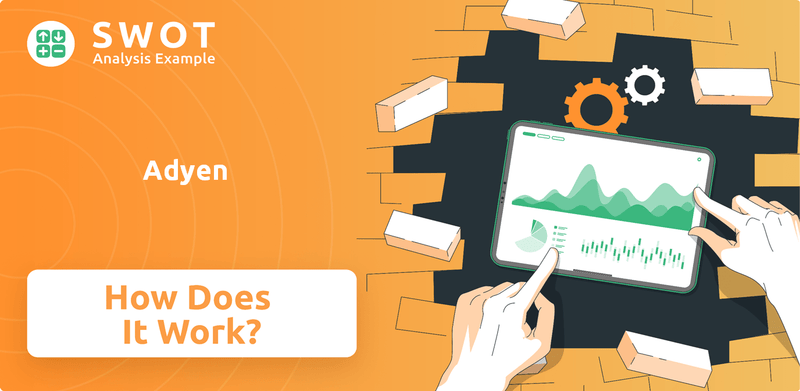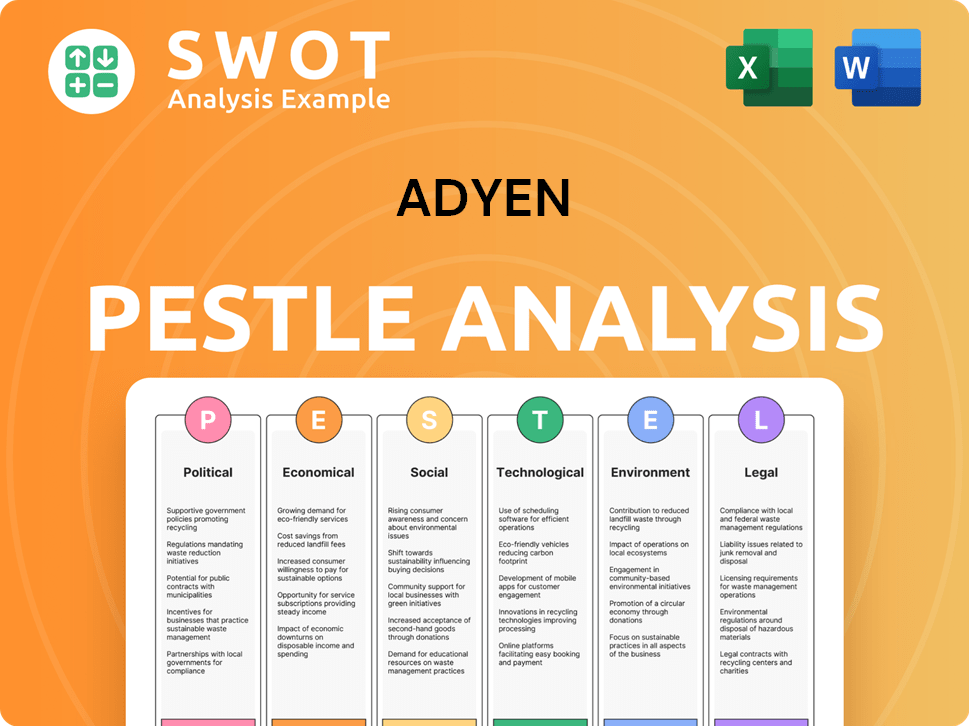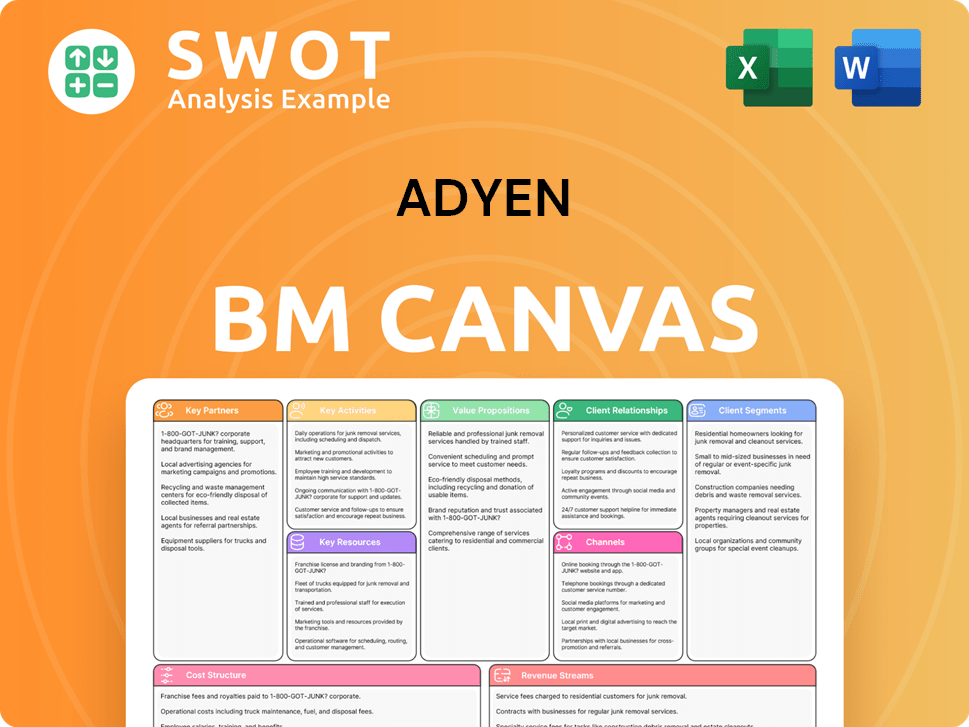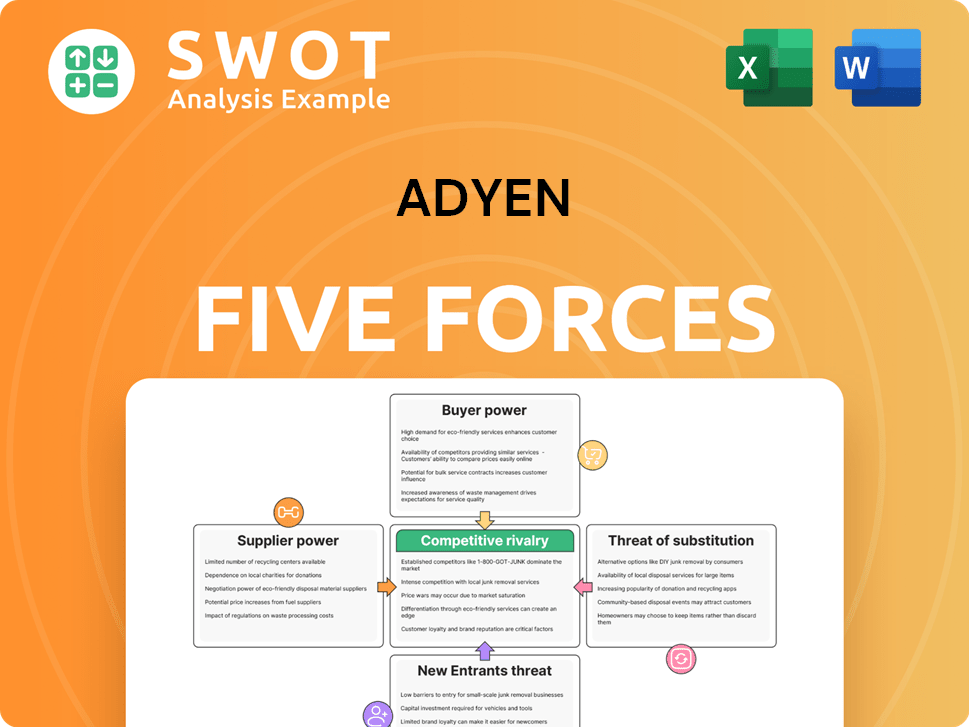Adyen Bundle
How Does Adyen Power Global Commerce?
Adyen has revolutionized the fintech landscape, becoming a cornerstone for businesses worldwide. In 2024, this powerhouse processed a staggering €1.29 trillion in payments, showcasing its dominance in Adyen SWOT Analysis. Its unified platform simplifies complex payment processing, offering a comprehensive suite of services that drive efficiency and growth for its clients. Major brands like Meta and Uber trust Adyen for its robust payment solutions.

This exploration will delve into how Adyen works, examining its core operations and monetization strategies. Discover how Adyen payment processing facilitates online payments and empowers businesses with a seamless payment gateway. Understanding Adyen's features, from its global payment processing capabilities to its detailed reporting and analytics, is key to appreciating its impact on the future of commerce. Businesses considering Adyen for small businesses or larger enterprises should understand the Adyen benefits.
What Are the Key Operations Driving Adyen’s Success?
The core of Adyen's operations centers on its unified financial technology platform, designed to simplify global payments for businesses. This platform provides comprehensive payment solutions, directly connecting to major networks like Visa and Mastercard, alongside over 250 local payment methods. This direct connection allows merchants to optimize authorization rates and reduce fraud, giving them a complete view of their payment data.
Adyen serves a diverse customer base, primarily focusing on large global businesses, but also extending its reach to small and medium-sized businesses (SMBs) through its 'Adyen for Platforms' offering. This platform enables other platforms, such as SaaS providers, to integrate Adyen's payment processing for their sub-merchants, effectively aggregating smaller merchants onto Adyen's infrastructure. In the first half of 2024, Adyen had 104,000 platform business customers, with the number of transacting platform terminals nearly doubling year-over-year to 165,000.
Adyen's operational processes are built on its proprietary technology stack, which handles online, in-app, and in-store payments. This unified commerce approach provides a centralized view of all transactions and customer data, enhancing operational efficiency and customer experience. The company also offers its own payment terminals and point-of-sale (POS) software, all connected to the same backend. A notable product launch in 2024 was the SFO1 terminal, a multimedia countertop Android terminal designed to enhance in-person payment experiences. Adyen also leverages AI across its platform, with products like Adyen Uplift for conversion optimization and Intelligent Payment Routing, which dynamically chooses the optimal route for a transaction to balance conversion, risk, and cost. Adyen's supply chain and distribution networks are supported by its in-house licenses, including a European banking license and multiple acquiring licenses worldwide. This regulatory status allows Adyen to operate as a direct clearing partner in many markets, reducing reliance on third parties and increasing control over payment flows. For example, in 2024, Adyen became one of the first non-traditional banks directly connected to FedNow, the new U.S. instant payments network.
Adyen offers comprehensive payment solutions, supporting a wide range of payment methods and currencies. They provide a unified platform for online, in-app, and in-store payments, streamlining the payment process for businesses. This integrated approach simplifies operations and enhances customer experience.
Key Adyen features include direct connections to payment networks, advanced risk management tools, and detailed reporting and analytics. They also offer features like Adyen Uplift for conversion optimization and Intelligent Payment Routing. These features help businesses optimize their payment processes and improve their bottom line.
Adyen's 'Adyen for Platforms' offering allows platforms to integrate payment processing for their sub-merchants. This solution is designed for marketplaces, SaaS providers, and other platforms that need to manage payments for multiple businesses. It simplifies payment management and helps platforms scale efficiently.
Adyen's technology stack is built in-house, providing full control over its payment infrastructure. This allows for high performance, scalability, and customization. Adyen's technology supports online, in-app, and in-store payments, offering a unified commerce experience.
Adyen's value proposition lies in its single, full-stack platform, which eliminates the need for merchants to integrate multiple providers. This integrated approach simplifies operations, reduces costs, and provides a seamless experience. This is a key differentiator in a fragmented market. Learn more about the Growth Strategy of Adyen.
- Unified Platform: A single platform for all payment needs, simplifying operations.
- Direct Connections: Direct connections to major payment networks, optimizing performance.
- Global Reach: Support for a wide range of payment methods and currencies worldwide.
- Advanced Features: AI-driven tools for conversion optimization and intelligent routing.
Adyen SWOT Analysis
- Complete SWOT Breakdown
- Fully Customizable
- Editable in Excel & Word
- Professional Formatting
- Investor-Ready Format

How Does Adyen Make Money?
Adyen's revenue model centers on transaction fees, utilizing an interchange++ pricing structure. This approach offers transparency, breaking down fees into interchange, scheme, and acquirer components. This structure allows businesses to understand the exact costs associated with each transaction processed through the Adyen payment gateway.
The company's fees consist of a fixed processing charge plus a variable fee dependent on the payment method or card network. For example, rates for Visa and Mastercard can start at $0.13 plus a 0.60% markup over interchange++. These rates are often negotiable and can decrease with higher transaction volumes, making Adyen payment processing a scalable solution for businesses of all sizes.
In 2024, Adyen's net revenue reached €1.996 billion, demonstrating a 23% year-over-year increase. The company's EBITDA for 2024 was €992.3 million, marking a 34% increase year-over-year, with an EBITDA margin of 50%.
Adyen's revenue streams are diversified across several segments, each contributing significantly to its overall financial performance. The company's ability to offer comprehensive Adyen payment solutions for e-commerce and other business models has fueled this growth.
- Digital: This segment remains the largest, with a processed volume of €783.4 billion in FY 2024, up 29% year-over-year.
- Unified Commerce: This segment, which integrates online and in-store payments, grew significantly, with processed volumes reaching €334.8 billion for FY 2024, a 32% year-over-year increase.
- Platforms: This is Adyen's fastest-growing segment, with platform volume growing 51% year-over-year in 2024. In Q1 2025, the Platforms segment saw the highest growth at 63% year-over-year in net revenue. Adyen reported 30 platform customers processing over €1 billion annually in Q1 2025, up from 19 a year ago.
- Issuing: Adyen's Issuing product saw its volumes grow by 258% year-over-year in 2024. This forms part of Adyen's Embedded Financial Products (EFP) suite, allowing businesses to generate new revenue streams by offering financial services.
Adyen's geographical diversification is a key aspect of its monetization strategy. The company's presence in various regions allows it to capture growth opportunities globally. Understanding the dynamics of each region is critical for assessing Adyen's overall performance, and the Marketing Strategy of Adyen provides further insights.
- EMEA: The largest revenue contributor, with net revenue growing 27% year-over-year in H2 2024, reaching €1.1 billion for the full year.
- North America: A key strategic region, with net revenue growing 21% year-over-year in H2 2024.
- Latin America: Saw a 1% decline in H2 2024 due to foreign exchange headwinds, but underlying growth was 12%.
Adyen employs several innovative strategies to maximize revenue and enhance customer value. The company focuses on acquiring large enterprise customers and expanding its services alongside them, resulting in a low churn rate.
- Adyen Uplift: An AI-powered optimization suite that improved payment conversion rates by up to 6% in a 2024 pilot.
- Land-and-Expand Strategy: Focuses on acquiring large enterprise customers and growing alongside them.
- Low Churn Rate: Less than 1%, indicating strong customer retention.
Adyen PESTLE Analysis
- Covers All 6 PESTLE Categories
- No Research Needed – Save Hours of Work
- Built by Experts, Trusted by Consultants
- Instant Download, Ready to Use
- 100% Editable, Fully Customizable

Which Strategic Decisions Have Shaped Adyen’s Business Model?
Adyen has achieved significant milestones, shaping its operations and financial performance. A key strategic move has been its consistent organic growth strategy, emphasizing in-house infrastructure development rather than acquisitions. This approach provides full control over its platform, which Adyen believes is crucial for performance and customer satisfaction.
In 2024, Adyen continued to expand globally, particularly in India, where it received authorization from the Reserve Bank of India. The company also strengthened direct banking connections, becoming one of the first non-traditional banks directly connected to FedNow and integrating with the UK's Faster Payments system. These direct connections enhance payout speed, flexibility, and reliability.
Product innovation has been a key driver for Adyen. In 2024, the company launched AI-based products like Adyen Uplift for conversion optimization and expanded its Intelligent Payment Routing capabilities. These tools leverage Adyen's extensive data to optimize payment flows, balance conversion, risk, and cost, and improve authorization rates. The company also introduced the SFO1 terminal, a proprietary multimedia countertop Android terminal designed to enhance in-person payment experiences, further solidifying its unified commerce offering, which saw volumes grow 35% year-over-year in H2 2024.
Adyen's journey has been marked by several pivotal moments. These include strategic expansions into new markets and the development of innovative payment solutions. These milestones have helped Adyen solidify its position as a leading payment processing provider.
Adyen's strategic moves focus on organic growth and in-house development. This approach allows for greater control over the platform and ensures high performance. These strategies have been crucial in maintaining a competitive edge in the market.
Adyen's competitive advantages stem from its technology and integrated platform. Its single-stack architecture offers superior performance and higher payment acceptance rates. This unified platform simplifies global payments for merchants.
Adyen continues to innovate and expand its services. The company is focused on enhancing its platform and building strong partnerships. This includes investments in research and development to adapt to new trends and technology shifts.
Adyen's competitive advantages lie in its technology, integrated platform, and customer-centric approach, resulting in a low churn rate of less than 1%. However, the company faces challenges such as increasing competition, particularly in the U.S., and macroeconomic impacts on transaction volumes. To learn more about the company's origins and early strategies, you can read a brief history of Adyen.
- Single-Stack Architecture: Provides superior performance and higher payment acceptance rates.
- Direct Connections: In-house licenses and direct connections to payment networks offer a lower cost-of-service.
- Customer-Centric Approach: 'Land-and-expand' strategy with large enterprise clients contributes to a low churn rate.
- Challenges: Increasing competition, especially in the U.S. market, and macroeconomic factors.
Adyen Business Model Canvas
- Complete 9-Block Business Model Canvas
- Effortlessly Communicate Your Business Strategy
- Investor-Ready BMC Format
- 100% Editable and Customizable
- Clear and Structured Layout

How Is Adyen Positioning Itself for Continued Success?
As a leading financial technology platform, Adyen holds a strong position in the market, especially for large enterprise clients seeking unified commerce solutions. Its global reach is significant, with a processed volume of €1.29 trillion in 2024. The company's strong customer loyalty is evident through its low churn rate of less than 1% and a Net Promoter Score (NPS) of 66, showcasing its ability to retain and satisfy its client base.
Adyen's geographic revenue distribution in 2024 shows EMEA as the largest segment, generating 57.4% of revenue, followed by North America at 26.9%, Asia/Pacific at 10.3%, and Latin America at 5.4%. This distribution highlights Adyen's global presence and diversification across various markets, although it also indicates a heavy reliance on the EMEA region.
Adyen is a key player in the online payments sector, offering comprehensive payment solutions. Its focus on enterprise clients and unified commerce sets it apart. The company's strong market position is supported by its high transaction volume and customer loyalty.
Adyen faces risks such as intensifying competition, particularly in the U.S., and regulatory changes. Macroeconomic factors, like currency volatility, can also impact its performance. The company acknowledges the potential impact of a decline in volume from a single large customer.
Adyen anticipates sustained growth, targeting net revenue growth in the low-twenties to high-twenties percentage through 2026. Strategic initiatives include platform innovation, global expansion, and building strong partnerships. The company is well-positioned to capitalize on the digital payments shift.
Adyen provides comprehensive payment processing services for businesses worldwide. Their platform supports various payment methods and currencies. Businesses can benefit from Adyen's robust payment gateway and features.
Despite its strengths, Adyen faces several risks. Competition is intensifying, especially in the U.S. market, where established players are focusing on value. Regulatory changes in the payments landscape and the need to manage operational costs are also critical. Macroeconomic conditions, such as currency volatility and shifts in consumer spending, can impact transaction volumes and profitability. As detailed by Owners & Shareholders of Adyen, understanding these factors is crucial for investors.
Adyen is focused on continuous innovation of its platform, expanding its global footprint, and building strong partnerships. These initiatives are designed to enhance its services and reach a wider customer base. Investments in new features and capabilities, including AI-driven tools, are a priority.
- Platform Innovation: Continuous improvements to payment processing technology.
- Global Expansion: Targeting growth in North America, India, and Japan.
- Partnerships: Building strategic alliances to enhance service offerings.
- AI-Driven Tools: Development of features like Intelligent Payment Routing and Uplift.
Adyen Porter's Five Forces Analysis
- Covers All 5 Competitive Forces in Detail
- Structured for Consultants, Students, and Founders
- 100% Editable in Microsoft Word & Excel
- Instant Digital Download – Use Immediately
- Compatible with Mac & PC – Fully Unlocked

Related Blogs
- What are Mission Vision & Core Values of Adyen Company?
- What is Competitive Landscape of Adyen Company?
- What is Growth Strategy and Future Prospects of Adyen Company?
- What is Sales and Marketing Strategy of Adyen Company?
- What is Brief History of Adyen Company?
- Who Owns Adyen Company?
- What is Customer Demographics and Target Market of Adyen Company?
Disclaimer
All information, articles, and product details provided on this website are for general informational and educational purposes only. We do not claim any ownership over, nor do we intend to infringe upon, any trademarks, copyrights, logos, brand names, or other intellectual property mentioned or depicted on this site. Such intellectual property remains the property of its respective owners, and any references here are made solely for identification or informational purposes, without implying any affiliation, endorsement, or partnership.
We make no representations or warranties, express or implied, regarding the accuracy, completeness, or suitability of any content or products presented. Nothing on this website should be construed as legal, tax, investment, financial, medical, or other professional advice. In addition, no part of this site—including articles or product references—constitutes a solicitation, recommendation, endorsement, advertisement, or offer to buy or sell any securities, franchises, or other financial instruments, particularly in jurisdictions where such activity would be unlawful.
All content is of a general nature and may not address the specific circumstances of any individual or entity. It is not a substitute for professional advice or services. Any actions you take based on the information provided here are strictly at your own risk. You accept full responsibility for any decisions or outcomes arising from your use of this website and agree to release us from any liability in connection with your use of, or reliance upon, the content or products found herein.